To accomplish your tasks, you’ll need to set up a process that will allow you to complete them quickly and also give the best results.
Sometimes the design process can be a jungle of trends and patterns; it involves a lot of back and forth to produce the best design solutions. No design is the final design; every procedure can be iterated on.
This is why the Design Council came together in 2005 to develop a new approach to designing solutions with creative thinking, systems design, and design management in mind: the Double Diamond design process. The process has also had its share of improvements over the years; let’s talk about how modern Double Diamond design works and how you can apply it for a better design process.
- What is the Double Diamond process?
- Design Council’s 2019 framework vs. historical representation
- Steps in double diamond
What is the Double Diamond process?
The Double Diamond model is a design process developed in 2005 by the British Design Council. It is divided into four phases: discover, define, develop, and deliver.
The Double Diamond is a guide for understanding design problems and communicating solutions. The Double Diamond model serves as a visual representation and guide for the design process.
Since the 1960s, kite-shaped models have been referenced, but these models of the design process were not widely accepted at this point. Design thinking needed more visibility because every organization had a way they wanted their designs done and had different names for these processes. The Design Council thought of a way to bring these different phases and names under one umbrella term, and today, the Double Diamond is used and referenced worldwide.
Part of the Design Council’s reason for creating the Double Diamond was to address the need for more visibility in design processes. This description of the design process has become an accepted part of the design language.
Design Council’s 2019 framework vs. historical representation
The Double Diamond shapes were created by Béla H. Bánáthy and Nigel Cross in 1996. Béla and Nigel are design educators who studied systems design.
The Design Council’s framework for innovation is a guide that supports designers and nondesigners in solving complex social, economic, and environmental problems using human-centered design principles. They help product owners modernize the way they create and deliver their services.
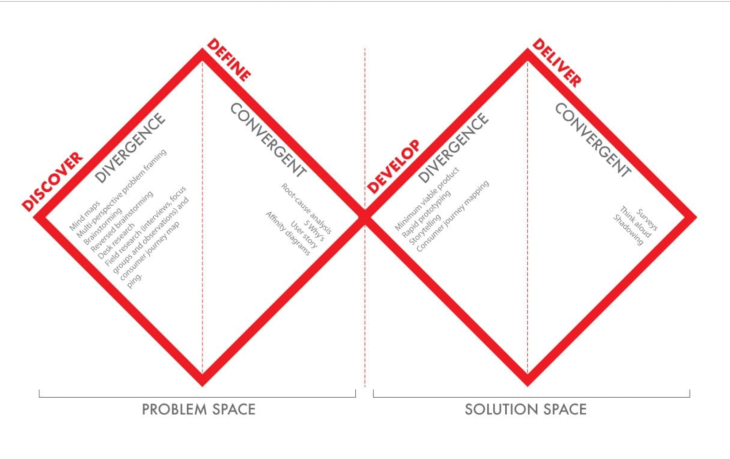
When the process was first developed in 2004, it was divided into two phases: the problem phase and the solution phase, with solutions designed using convergent and divergent methods. This 2004 model depicts the process as rigid and linear, in which one phase would need to be complete before moving on to the next phase. The solution would wait until the problem was defined and researched.
After a few years of using and observing this model, the UK Design Council made some changes to the process in 2019. They reasoned that design was not a linear process and that, depending on the project, team, and location, it could be a back-and-forth process with challenges and outcomes.
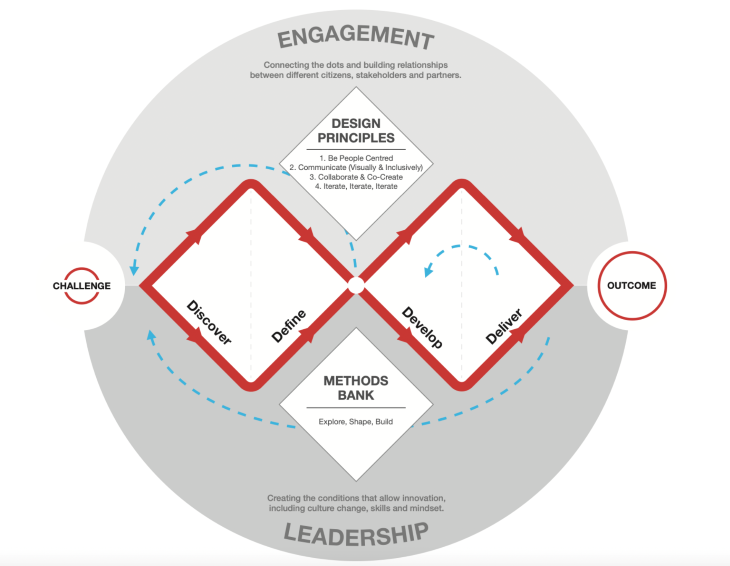
The 2019 update considered leadership and the importance of creating a safe space for design and innovation by accepting diversity and differences. It also prioritizes user, partner, and stakeholder engagement.
The 2019 framework for innovation outlines principles that designers and other problem solvers can choose to follow in order to work effectively. These principles include:
- Collaboration — working with others to be inspired
- People-centered — understand users and their needs
- Iterate — listen to your users and make changes as needed
- Communicate — speak to your users and team members in languages they understand, and use visuals as needed
Steps in the Double Diamond process
The model looks like two kites put together, giving it a diamond look. The first kite represents the problem phase, and the second kite represents the solution phase. The problem phase is divided into two steps, Discover and Define, while the solution phase is Design and Delivery.
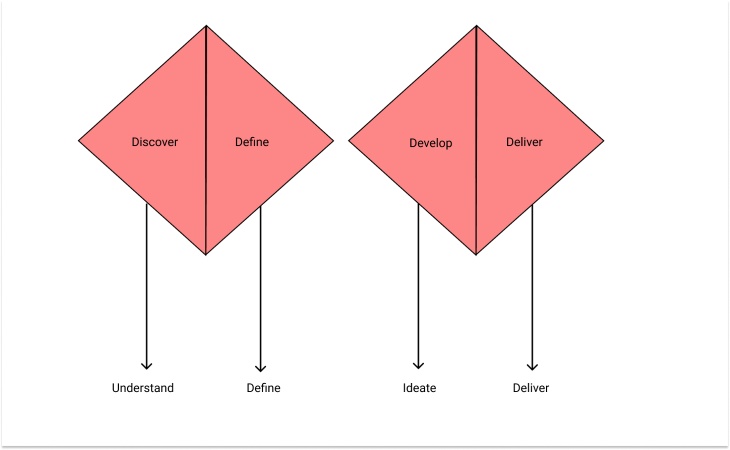
Discover
It is the first step in defining the scope of the problem. In this phase, the designer or design team explores the problems and challenges of the project. This aims to identify the project’s needs, target audience, delivery methods, etc.
In this step, we employ industry research strategies, and the design team sets out to explore them. This phase of the design process allows you to collect information regarding the challenge. At this time, all data collected should be documented and not discarded.
The Double Diamond method is not rigid in nature as most designers are led to believe; it is a guide for laying down your own process. As a designer, you can intend to start designing by laying out your thoughts and assumptions about the project during the discovery phase. In contrast, another designer may decide to start off the discovery phase by speaking to current users or target users before addressing their assumptions. The goal of this step is to learn more about the problem, its effects, objectives, and output (solution). Other processes in this stage include market research, competitive analysis, and user research.
User-centered design is adopted by many companies. As the design lead, you need to be clear on how you decide to start this phase. Depending on the team members and processes involved, you are bound to collect a large number of data that will influence the following stages of this design process; it is important to also discuss how to manage this information during this phase so you do not lose crucial data.
Example of the discover step
The game “4 Pics, 1 Word” is a puzzle game of 4 pictures where the player picks a name that is either relative to or common to all pictures. The only issue with the game is that players have to start over whenever they log out of it.
During the discovery phase, designers ask users and players of the game questions to learn how they feel about it and how better designs can help improve the game’s experience.
Using the Double Diamond design approach, my first duty was to discover the problem. I had friends who played the game regularly and others who had stopped. I asked them a few questions to understand their pain points and positive feedback regarding the game.
These were some of my sample questions:
- What do you like about the game?
- How often do you play?
- What’s your game progress?
- Why do you play the game?
- What is your least favorite feature?
As a next step, I conducted interviews and read reviews, articles, and other content about the game. I found out:
- It’s an educational puzzle game
- Its players are from 16–30+
- The app doesn’t ask for login details
The challenges:
- Users lost their progress on the game when they changed devices
- The pain of starting over sometimes makes casual customers of the game give up and also discourages other committed customers
- Players spend money playing the game without any real value; by implementing a “play to earn” feature, we allow players to make money as they play games. This can be in the form of crypto or NFTs. This serves as an incentive to encourage new and old players. Also, with the advent of blockchain, more gaming platforms are switching to “play-to-earn”
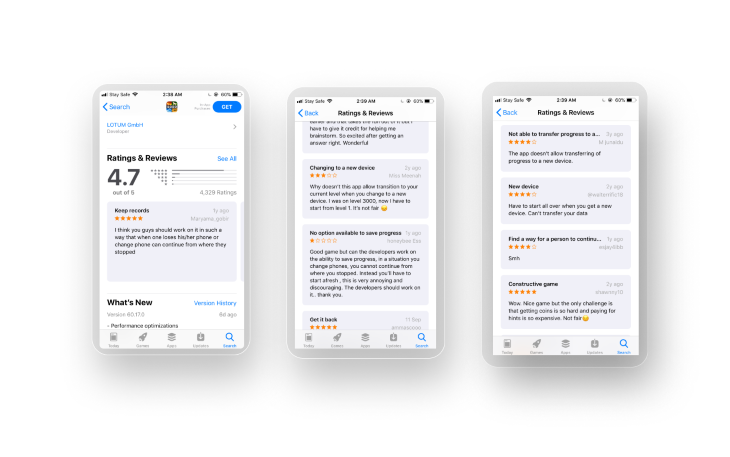
This laid out the first process in the problem phase and the first step in the Double Diamond design model. Next, we move on to step two.
Define
Define is the second step in the Double Diamond process; it is convergent in nature, meaning that in this phase, you are focused on getting a solution, and your thoughts and ideas are fixed (unlike step one, which was divergent and allowed you to welcome new ideas that influenced your decision).
In the define phase, the design team will analyze the data obtained. You will filter all your research data, user interviews, and personal design assumptions here. This is because you collect all the data during the discovery phase, and everything is important to you as a designer.
The define stage allows you to decide which data is important to your design solution and which should be discarded. You will not be working on this alone; you and the team of designers at your organization will discuss and decide which data is important to move into the solution phase.
In fact, at this stage, you have begun to work on your solutions. This teamwork can lead to identifying edge cases and unnecessary data. Since this process is flexible, you can always go back to the discovery phase to conduct more research if you are not satisfied with your present results.
The definition stage is also used to communicate the project goals and ensure the design team is aligned and everyone understands the project internally and externally. In this phase, personas are created, affinity maps are drawn, etc. Additionally, we work on setting the context for product development, assessing what is realistic, and analyzing how this project aligns with the corporate brand. The second stage of the Double Diamond model provides the foundation for product development.
Following up on the case study from the discover phase, I had to define the data collected so the team could understand the design needs. Below are some of the deliverables from this stage.
Here’s a persona from my research:
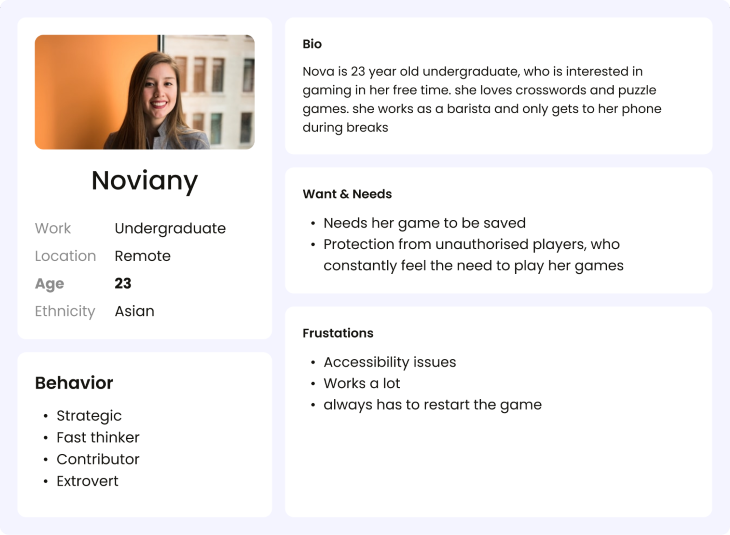
And an empathy map from the define stage:
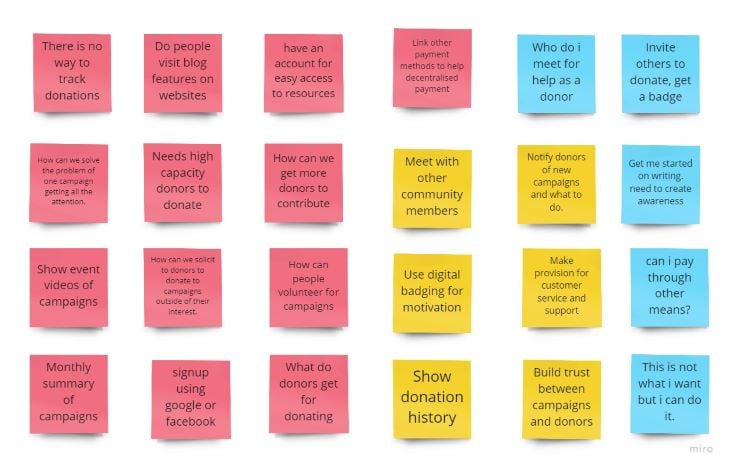
Develop
We have now entered the second “diamond” or “kite” of the model, which is also the solution phase. The first step in this process is the development step. In this step, we assume that the team not only understands the problem but has also done their research, filtered unnecessary data, and is now brainstorming and testing ideas.
In this step, all the research collected and sought has now been defined and put into visuals for clarity. This step allows you to use the personas created by the team to design sketches, wireframes, and prototypes of the solution. Some organizations may decide to develop the personas, journey maps, etc. in this phase, the deliver phase. In this phase, the solution is complete, and the product has been delivered to the public. Users can now download the final product and use it. It was tested in the previous stage by a select group of people.
Sometimes users may use the product or solution in ways the designer did not plan for. It is essential to receive feedback and monitor reviews and downloads, as this will affect your team’s evaluation of the product’s success. This feedback would be used to iterate on the product’s next release, as some products go on to have newer versions or even feature updates. This stage involves product sign-off, retrospective, product marketing, etc.
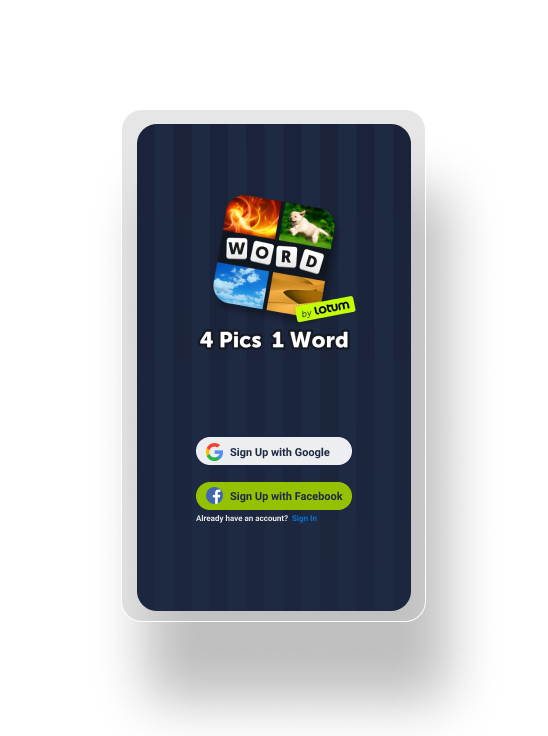
Retrospectives as part of the delivery stage
The insights were analyzed, and these were the follow-up iterations for my example project:
- Signing up with third-party accounts will save information about players
- To encourage further signups with these features, I introduced incentives to enable users to sign up for free and earn coins
- An option to invite friends and earn coins
- Signing up with Facebook allows you to share puzzles with your Facebook Community to get feedback
These solutions enable your information and game progress to be stored in the cloud, as well as earn while you play, and reuse information whenever you sign in to a new device.
Conclusion
The Double Diamond model is a methodology that can be used in a wide range of industries, not just design. It is a designer’s guide because it can be applied to any problem that requires a solution. It is a comprehensive approach to making good design decisions with users and solutions in mind.
As a designer, you may have designed a process that works for you, or your organization may have designed a process that works for designers; the Double Diamond assists you in breaking down these processes by having a problem and solution phase to help you design better solutions.
The post Modern Double Diamond design: Rethinking a classic design process appeared first on LogRocket Blog.
from LogRocket Blog https://ift.tt/o6ifIae
Gain $200 in a week
via Read more



